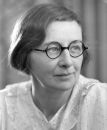Dorothy M. Needham facts for kids
Quick facts for kids
Dorothy M. Needham
|
|
|---|---|
 |
|
| Born | 22 September 1896 |
| Died | 22 December 1987 |
Dorothy Mary Moyle Needham (born September 22, 1896 – died December 22, 1987) was an English scientist who studied biochemistry. She was famous for her important work on how muscles work at a chemical level. She was also married to another biochemist, Joseph Needham.
Contents
Early Life and Education
Dorothy Mary Moyle was born in London. Her father, John Thomas Moyle, worked with patents, and her mother was Ellen Daves.
She went to school at Claremont College in Stockport and St Hilary's School in Alderley Edge. Later, she attended Girton College, Cambridge, which was one of the few colleges for women at the time.
At Cambridge, Dorothy became very interested in chemistry, especially the chemistry of living things, called biochemistry. She was inspired by lectures from a famous scientist named Frederick Gowland Hopkins.
After finishing her studies in 1919, she was offered a research job with Professor Hopkins. He was one of the few science leaders at Cambridge who gave research chances to women. She worked at the Sir William Dunn Institute of Biochemistry in Cambridge. She earned her Master of Arts degree in 1923 and her PhD in 1930.
Dorothy Moyle married fellow biochemist Joseph Needham on September 13, 1924. They did not have any children.
Her Scientific Work
Dorothy Needham's first big research project looked at how lactic acid and glycogen change into each other in muscles. This helped explain how muscles get and store energy.
She then studied how other chemicals, like succinic acid, fumaric acid, and malic acid, help muscles create energy. She also explored the differences between how muscles work with oxygen (called aerobic) and without oxygen (called anaerobic).
Later, she studied how energy is moved around in muscles. In 1939, she and her team made an important discovery. They showed that myosin, a key protein that helps muscles contract, also acts like a special helper molecule called an ATPase enzyme. This was the first time scientists directly linked a muscle's structure to its function.
World War II Contributions
During World War II, Dorothy Needham joined a group that studied chemical defense. This group was led by Professor Malcolm Dixon. Her work focused on how chemical weapons, like mustard gas, affected skin and the body's cells.
Work in China and Royal Society
In 1944, her husband, Joseph Needham, became a science advisor at the British embassy in Chungking (Chongqing), China. Dorothy went with him and became an associate director of a special office he set up there to help with science cooperation between Britain and China.
They returned to Cambridge in 1945. Dorothy continued her research on proteins and enzymes. She earned another advanced degree, a Doctor of Science. In 1948, she was chosen to be a Fellow of the Royal Society (FRS). This was a big honor, and it made the Needhams the first married couple to both be Fellows of the Royal Society.
In 1962, after more than 40 years of studying muscle chemistry, she finished her research with a study on the proteins in the smooth muscles of the uterus.
Her most important book, Machina Carnis: The Biochemistry of Muscular Contraction in its Historical Development, was published in 1971. It tells the story of all the discoveries in muscle chemistry since the 1600s.
Dorothy Needham was also an honorary fellow at Girton College, Cambridge. She helped start and was a fellow at Lucy Cavendish College, Cambridge. She was also an honorary fellow at Gonville and Caius College, Cambridge, where she was the first woman fellow.
Helping Others and Society
Dorothy and Joseph Needham were very active in social and political causes. They both represented scientific workers on the Cambridge Trade Council. Dorothy even ran as a candidate for the Labour Party for the Cambridge City Council.
She supported many organizations, including Amnesty International, which works for human rights, and Friends of the Earth, which focuses on the environment. She also helped groups that provided medical and scientific aid to countries like Vietnam.
Dorothy Needham also played a big role in creating two new colleges at Cambridge University for women who were doing research but didn't have a college to belong to. These were New Hall (started in 1946) and Lucy Cavendish College (started in 1962).
Images for kids
See also
 In Spanish: Dorothy M. Needham para niños
In Spanish: Dorothy M. Needham para niños


